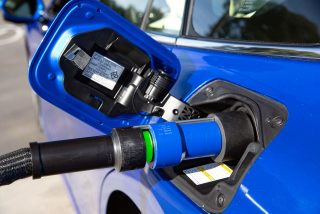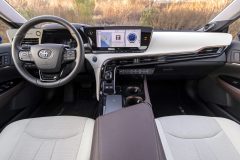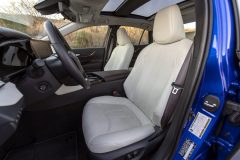All-new in Every Way
[Ed. note: Clean Fleet Report got two shots at the new Mirai; Gary Lieber’s tech deep dive is here.]

Forget everything you know about the Mirai, the hydrogen fuel cell sedan from Toyota with a curious design. This first generation car, which debuted in 2017, could be seen (with a keen eye) cruising along California and Hawaii roads, but never in great quantities. For most people, it was invisible. This won’t be an issue with the all-new 2021 Toyota Mirai fuel cell electric vehicle (FCEV) as it has been completely reborn with an upscale design that suggests it could be a Lexus. This Flash Drive review gives a taste of our impressions driving the 2021 Mirai for a few hours. We will do a follow-up Road Test review after having the opportunity to get behind the wheel for a week, or longer.
Redesigned, Reimagined

When Clean Fleet Report reviewed the first generation 2017 and 2019 Toyota Mirai, we found it was a comfortable riding midsize sedan with a respectable 312 miles of electric driving range. We weren’t all that excited about the look, and quickly learned it cornered okay, but elicited nothing exciting or fun. Since it wasn’t meant to be driven hard on corners, expectations were met. But all that has changed.
The all-new 2021 Mirai is a great-looking five-seat sedan with increased electric driving range and handling that makes you say–“Oh yeah!” Based on the Lexus LS platform, the second generation Mirai has made a giant leap into respectability for exterior design, interior comfort, driver safety systems and the ability to go up to 400 miles on a tank of hydrogen. Another big difference from the earlier Mirai is the 2021 Mirai is rear-wheel drive, a significant change that improves the handling and ride.
Getting There: Creating Electricity
The electric power comes from hydrogen and oxygen being introduced to a fuel cell. Through a chemical process, electricity is created to power the motor and charge the lithium-ion battery. The by-product of this chemical reaction is water vapor that harmlessly drips from the tailpipe, making the Mirai a true zero-emission vehicle at that tailpipe.
For those that like statistics, here we go.
- 182 horsepower
- 221 pound-feet of torque
- 76 mpg city/71highway/74 combined (maximum MPGe estimate)
- Note: MPGe, or miles per gallon equivalent, is a measurement of how efficient a car powered by electricity is, using the same amount of energy as is contained in one gallon of gasoline.
- Battery power output: 310.8 Volts
- Battery capacity 1.24 kWh
- Three carbon-fiber reinforced hydrogen tanks, with a three-layer structure
- Hydrogen tank capacity: 5.6 kilograms/12.35 pounds
Getting There: Hitting the Open Road
Clean Fleet Report drove the 2021 Toyota Mirai about 75 miles, from the Pelican Hill Resort in Newport Beach, California, to The Candy Store on Ortega Highway 74, and back. We experienced rolling hills at 70+ mph on a wide open highway, then the twisty, and at times challenging, Ortega Highway. If you are unfamiliar with Highway 74, just ask any sports car enthusiast or motorcyclist, and they will tell you all about it.

The Mirai’s hydrogen fuel cell system is completely seamless, resulting in smooth, linear acceleration with 0-60 times in about nine seconds. Not fast as far as electric cars go, but certainly quick enough to merge onto highways and pass big rigs.
The performance was so good, with a near silent driving experience coming from the hydrogen-powered electric motor, that it was easy to forget a science project was taking place under the hood. To maximize performance, electricity consumption and driving range, the 2021 Mirai has regenerative braking, and three driver-selectable drive modes of Eco, Normal and Sport. On the open road Eco is the place to be, Sport is for a more responsive accelerator and a tighter steering wheel resulting a better road feel, and Normal is a combination of the two.
The handling was seriously improved over the first generation Mirai, to the point you will want to seek out corners and curves. The move to rear-wheel drive, a 50/50 weight balance, the motor and hydrogen fuel tanks being placed low to the ground, and Active Cornering Assist all contributed to what is a very fine handling sedan.
Outside and Inside

The all-new 2021 Mirai is the best-looking Toyota sedan. Sorry Avalon, Camry, Corolla, and Prius, it just is. With Lexus design cues taking the Mirai upscale, the question was–why is it not part of the Lexus line? Toyota says the Mirai is a car for everyone, and not just a luxury car. The consumer wins on this point, as being able to own a Toyota with a Lexus hidden underneath is a nice benefit.
The interior also has been completely reworked to exude elegance. With every creature comfort available, including leather, power everything, excellent sound systems and, on the Limited model, rear side window shades and a power rear window shade. The standard and available advanced driver assist systems (ADAS) are extensive and include the latest safety technology.
The Ownership Experience
While consumer ownership of a hydrogen fuel cell vehicle has been proven to be safe and reliable, there still are a couple unique considerations to owning a Mirai. It is only sold in California at eight dealers–and one in Hawaii. In the Golden State there currently are 42 public hydrogen fueling stations and one in Hawaii. That number in California grows to 69 by the end of 2021, and is projected to be more than 150 by 2025.

With four dealers each in northern and southern California, and those being grouped in heavy population areas, the dealer experience will be far different than any other car you have owned. Not bad, just different. The electric driving range now exceeding 400 miles means you don’t necessarily need to live near a dealership, as long as you always pay close attention to your hydrogen consumption and driving range, which are clearly displayed on the dash gauges.
The fueling process itself is pretty straight forward and simple. If you can fill a tank with gasoline, then you will have no problems with hydrogen. Once at the station, the fueling process is explained in a video that plays on the pump, with step-by-step instructions. Quick lesson: The nozzle notches into the filler tube, followed by the twisting of a handle to lock the nozzle in place. It can be a bit tricky, but be patient, it will eventually fit. If there are two pressure options on your pump, you always want to select 70 Bar, which is 10,000 psi. The filling will start and stop for a few seconds at a time, but a complete fill is under five minutes. When removing the nozzle you will notice it is cold. This is because the hydrogen gas is cooled to right around zero degrees Fahrenheit to increase the hydrogen’s density, which results in more gas filling the tank. That’s it!
Pricing
The good news from Toyota is the 2021 Mirai has a base price $9,000 less than the current model. Add-in a 30-percent increase in driving range, the great new looks and an increase in the number of hydrogen fuel stations, and the Mirai begins to be a viable alternative to gasoline–and even battery electric cars.

The 2021 Toyota Mirai, which goes on sale this month (December 2020), comes in two grades. These prices do not include options or the destination fee.
- XLE $49,500
- Limited $66,000
But wait, there’s more! The Mirai qualifies for federal tax credits and California incentives that could reduce your final cost, and comes with a pre-loaded debit card with up to $15,000 of complimentary hydrogen. The extended ToyotaCare maintenance is good for three years or 35,000 miles, roadside assistance for three years (unlimited miles), an eight-year/100,000-mile FCEV warranty on key fuel cell electric vehicle components, and a complimentary Toyota rental for up to 21 days during the first three years of ownership. This last one is a great benefit if there comes a time when you are planning a family vacation that takes you away from the hydrogen fueling station network.
And if all that isn’t enough incentive to give hydrogen a look, the Mirai qualifies for California’s coveted car pool sticker, allowing the driver, with no passenger, to use the HOV lane. This is no small thing when trying to get anywhere on a freeway in California.
Observations: 2021 Toyota Mirai Hydrogen Fuel Cell Electric Vehicle (FCEV)
Toyota is making a very strong case for the hydrogen powered Mirai to be sitting in your garage. The obstacles of design, ride, performance and driving range have been addressed in a big way. So, will a Mirai fit your lifestyle and driving pattern? If you are considering buying a midsize sedan, then quite possibly it could.

The Mirai drives and handles like any other car, actually better than many other cars, has the performance of an electric car (which it should because it is an electric car) and gets stellar fuel economy. If you are comparing it to an electric car, then it has the advantage of refilling the full driving range in a matter of minutes as opposed to possibly hours.
Clean Fleet Report will do a full Road Test review sometime in early 2021. After having the Mirai for a week or more we will cover the real world driving range, the comfort for five adults on a mini road trip, the cabin systems and the overall impressions after a few hundred miles of driving on California roads.
Story by John Faulkner. Photos courtesy of Toyota.
Make sure to opt-in to the Clean Fleet Report newsletter (top right of page) to be notified of all new stories and vehicle reviews.
Related Stories You Might Enjoy—The Mirai Fuel Cell Journey So Far
Road Test: 2019 Toyota Mirai
News: Toyota Moves into the Big Truck Business with a Fuel Cell
News: Toyota Mirai Hydrogen Fuel Cell Vehicle Passes 3,000 Sales
Road Test: 2017 Toyota Mirai
News: 2016 Toyota Mirai Hits the Market
First Drive: 2016 Toyota Mirai FCEV
Disclosure:
Clean Fleet Report is loaned free test vehicles from automakers to evaluate, typically for a week at a time. Our road tests are based on this one-week drive of a new vehicle. Because of this we don’t address issues such as long-term reliability or total cost of ownership. In addition, we are often invited to manufacturer events highlighting new vehicles or technology. As part of these events we may be offered free transportation, lodging or meals. We do our best to present our unvarnished evaluations of vehicles and news irrespective of these inducements.
Our focus is on vehicles that offer the best fuel economy in their class, which leads us to emphasize electric cars, plug-in hybrids, hybrids and diesels. We also feature those efficient gas-powered vehicles that are among the top mpg vehicles in their class. In addition, we aim to offer reviews and news on advanced technology and the alternative fuel vehicle market. We welcome any feedback from vehicle owners and are dedicated to providing a forum for alternative viewpoints. Please let us know your views at publisher@cleanfleetreport.com.













26 thoughts on “Flash Drive: 2021 Toyota Mirai FCEV”